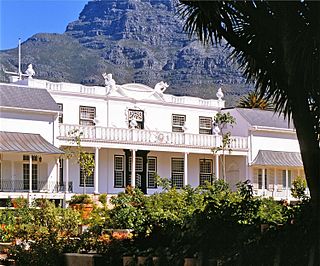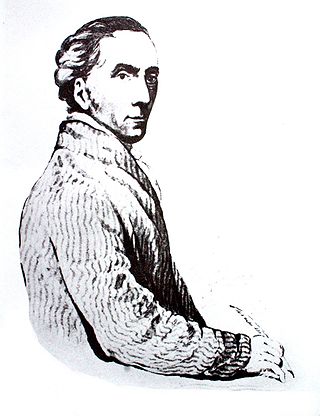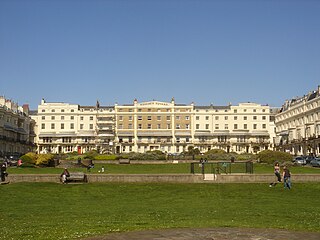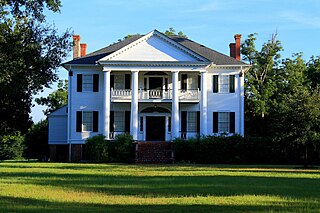
Boers are the descendants of the proto Afrikaans-speaking Free Burghers of the eastern Cape frontier in Southern Africa during the 17th, 18th, and 19th centuries. From 1652 to 1795, the Dutch East India Company controlled Dutch Cape Colony, but the United Kingdom incorporated it into the British Empire in 1806. The name of the group is derived from Trekboer then later "boer", which means "farmer" in Dutch and Afrikaans.

Casa Vicens is a modernist building situated in the Gràcia neighbourhood of Barcelona. It is the work of architect Antoni Gaudí and is considered to be his first major project. It was built between 1883 and 1885, although Gaudí drew up the initial plans between 1878 and 1880. The work belongs to the orientalist style, similar to Neo-Mudéjar architecture, although interpreted in Gaudí’s own personal way, with a uniqueness that only he knew how to add to his projects. In this work, and for the first time, Gaudí outlined some of his constructive resources that would become regular features throughout the emergence of Modernisme. The work was widely discussed when it was built and caused a great sensation among the general public at the time. When the building was constructed, Gràcia was still an independent urban nucleus of Barcelona; it had its own council and was classified as a town, though nowadays it is a district of the city.

The Castle of Good Hope is a bastion fort built in the 17th century in Cape Town, South Africa. Originally located on the coastline of Table Bay, following land reclamation the fort is now located inland. In 1936 the Castle was declared a historical monument and following restorations in the 1980s it is considered the best preserved example of a Dutch East India Company fort.

De Tuynhuys is the office of the president of South Africa, located in Cape Town.

Groot Constantia is the oldest wine estate in South Africa and provincial heritage site in the suburb of Constantia in Cape Town, South Africa.

The Webb Horton House, is an ornate 40-room mansion in Middletown, New York, United States, designed by local architect Frank Lindsey. Built 1902-1906 as a private residence, since the late 1940s it has been part of the campus of SUNY Orange. This building is now known as Morrison Hall, after the last private owner, and houses the college's main administrative offices. A nearby service complex has also been kept and is used for classrooms and other college functions.

Louis Michel Thibault, was a French-born South African architect and engineer who designed numerous buildings in the Cape Colony. He was South Africa's first trained architect and brought with him a distinctive mannered neo-classicism.

The E.W. Marland Mansion is a 43,561 square feet (4,046.9 m2) Mediterranean Revival-style mansion located in Ponca City, Oklahoma, United States. Built by oil baron and philanthropist Ernest Whitworth (E.W.) Marland, as a display of wealth at the peak of the 1920s oil boom, the house is one of the largest residences in the southwestern United States, and is known as the "Palace on the Prairie." It was designated a National Historic Landmark in 1973, and is now a museum open to the public.
Anton Anreith was a sculptor and woodcarver from Riegel near Freiburg in Breisgau, Baden, Germany. He is known for numerous sculptural embellishments that adorn buildings in the Cape region of South Africa, thought to represent the crowning achievement of the Cape Baroque style.
William Fehr was a South African businessman and art collector noted for his acquisition of famous artworks, known as The William Fehr Collection, now on display in the Castle of Good Hope in Cape Town. The collection was made publicly available for the first time in 1952 when Fehr and other collectors were invited to display historic pieces at the castle. A decade later the collection was purchased by the state and is now owned by The Department of Arts and Culture of South Africa.

Regency Square is a large early 19th-century residential development on the seafront in Brighton, part of the British city of Brighton and Hove. Conceived by speculative developer Joshua Hanson as Brighton underwent its rapid transformation into a fashionable resort, the three-sided "set piece" of 69 houses and associated structures was built between 1818 and 1832. Most of the houses overlooking the central garden were complete by 1824. The site was previously known, briefly and unofficially, as Belle Vue Field.

A slave mutiny on Meermin, one of the Dutch East India Company's fleet of slave ships, took place in February 1766 and lasted for three weeks. Her final voyage was cut short by the mutiny of the Malagasy captives onboard, who had been sold to Dutch East India Company officials on Madagascar to be enslaved by the company in its Cape Colony in southern Africa. During the mutiny half the ship's crew and almost 30 Malagasy captives died.

Youpon Plantation, originally known as Mimosa and also known as the Mathews-Tait-Rutherford House, is a historic antebellum plantation house and complex near Canton Bend, Alabama, United States. The three story Greek Revival-style plantation house was completed in 1848. It was extensively recorded by the Historic American Buildings Survey in 1936 and 1937. It was named for the Yaupon holly trees that were once a prominent feature of the front grounds. Architectural historians at the Alabama Historical Commission consider it to be among the most notable of the "stately pillared houses" in Alabama.

Exchange Hotel is a heritage-listed hotel at 134-138 Patrick Street, Laidley, Lockyer Valley Region, Queensland, Australia. It was designed by Eaton & Bates and built in 1902. It was added to the Queensland Heritage Register on 21 October 1992.

La Scala is a heritage-listed detached house at 517 Brunswick Street, Fortitude Valley, City of Brisbane, Queensland, Australia. It was designed by Thomas Ramsay Hall and built c. 1915. It was originally known as Craig Athol. It was added to the Queensland Heritage Register on 21 October 1992.

Cairns Court House Complex is a heritage-listed site incorporating a former courthouse and a former public administration building at 38–40 Abbott Street, Cairns City, Cairns, Cairns Region, Queensland, Australia. It was built from 1919 to 1921. It was added to the Queensland Heritage Register on 21 October 1992.

Junee Post Office is a heritage-listed post office at 119 Lorne Street, Junee, Junee Shire, New South Wales, Australia. It was designed by Designed by the Colonial Architect's Office under James Barnet and built by Gatby and Flock. The property is owned by Australia Post. It was added to the New South Wales State Heritage Register on 22 December 2000.
Casino Post Office is a heritage-listed post office at 102 Barker Street, Casino, Richmond Valley Council, New South Wales, Australia. It was designed by the NSW Colonial Architect's Office and built from 1879. The property is owned by Australia Post. It was added to the New South Wales State Heritage Register on 23 June 2000.

The Bertram House, located on Hiddingh Campus, of the University of Cape Town on Government Avenue, in Gardens, is the only surviving unpainted red brick two-story house left from early Georgian architecture in the city. The house has a special place in the history of the South African architecture. In 1962, it was declared a national monument, and today remains a provincial heritage site in accordance with the National Heritage Resources Act (25/1999).

Villa Mariënhof is a historic mansion with a garden located along the Bredaseweg in the Dutch city Tilburg. It was built between 1916 and 1918 as the residence of the family of a factory owner, and it was designed by Johan Wilhelm Hanrath. In 1986, it was inherited by Staatsbosbeheer, who first used Villa Mariënhof as an office and later rented it. The house itself, its teahouse, and the garden are rijksmonumenten.


















